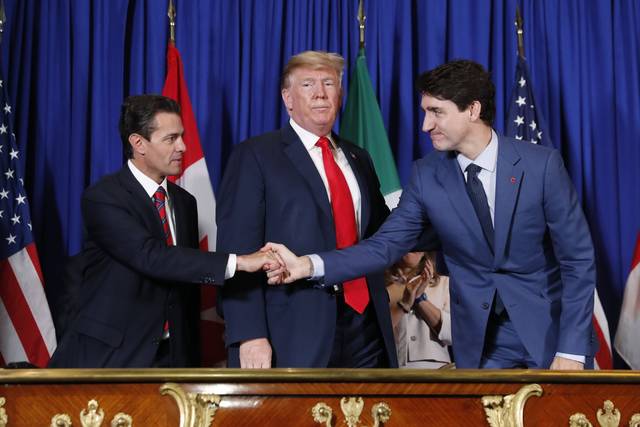President Donald Trump was elected in part on his promise to change the direction of U.S. trade policy so it would put America first. He has kept that promise with new trade agreements and tough enforcement actions that break down foreign trade barriers, protect America’s competitive edge and stop the outsourcing of U.S. jobs.
A key Trump success — and an important promise kept — has been to end the job-killing North American Free Trade Agreement (NAFTA) and replace it with a complete and long-overdue transformation.
When NAFTA went into effect more than 25 years ago, it was forecast to create 170,000 new U.S. jobs and keep our trade balance with Mexico in surplus well into the 2000s. Instead, NAFTA suppressed wage growth for American blue-collar workers in many industries while incentivizing American companies to outsource jobs to Mexico. Even as Mexico’s own workers saw little benefit, America’s trade deficit with Mexico soared.
NAFTA’s broken promises colored every subsequent debate over U.S. trade policy. Virtually every U.S. trade agreement since has received less and less bipartisan support in Congress.
To replace NAFTA, Trump negotiated a modern, state-of-the-art trade agreement with Mexico and Canada that will be the model by which all future trade agreements are judged.
The new United States-Mexico-Canada Agreement (USMCA) — which goes into effect on July 1 — is designed to create more manufacturing jobs in the U.S., secure greater access for American exports, and enhance America’s leadership in technology and innovation.
The overwhelming vote of support the USMCA received in Congress — more votes than any other trade agreement — is further proof that Trump has succeeded in charting a bold new course for America’s trade policy.
This history-making agreement increases country of origin requirements for auto manufacturing from 62.5% under NAFTA to 75%. This means at least three-quarters of autos and trucks qualifying for tariff benefits will be made in North America. More of those cars and trucks sold in North America will also be built by workers earning at least $16 per hour, reducing the wage disparity that led to the outsourcing of U.S. manufacturing jobs. These provisions are a main reason why the USMCA is expected to create 76,000 new jobs in the U.S. automotive sector alone over the next five years.
The USMCA is also a big win for our farmers. The U.S. has secured greater access to the Canadian dairy market as well as more opportunities to export American poultry and eggs. Additionally, Canada agreed to stop dumping millions of dollars in subsidized dairy products that squeeze American producers out of third-country markets. Furthermore, the USMCA takes steps to fix Canada’s discriminatory grain grading system that put American wheat growers at a competitive disadvantage. We can expect a $2.2 billion increase in U.S. agriculture and food exports thanks to the USMCA.
For the small businesses that keep our economy competitive and dynamic, the USMCA makes it easier for them to participate in cross-border trade and tap into foreign markets by updating trade rules that will lower costs and cut burdensome red tape.
The USMCA also includes a first-of-its-kind review and termination provision to ensure we never again find ourselves with an outdated and unbalanced North American trade agreement. Under Trump, the United States will no longer “sell” access to our market forever; instead, we will lease it on terms that are reciprocal and fair, but also long enough to encourage investment.
Put NAFTA and the USMCA side-by-side and it is clear the USMCA is a far better trade deal for America’s workers, farmers, ranchers and businesses. According to the International Trade Commission (ITC), the USMCA will increase U.S. employment by 176,000 jobs. Its positive impact on our Gross Domestic Product will be more than double what the ITC projected for the multilateral Trans-Pacific Partnership.
In short, with the USMCA we will have stronger economic growth and more jobs. As our nation fights to recover from covid-19, nothing could be more important. Finally, an American president has delivered on his promises.
Robert Lighthizer is the United States trade representative.








